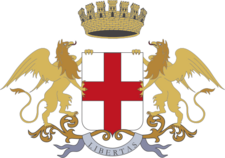Giovanni I di Murta facts for kids
Quick facts for kids
Giovanni I di Murta
|
|
|---|---|
 |
|
| 2nd Lifetime Doge of the Republic of Genoa | |
| In office 25 December 1345 – 6 January 1350 |
|
| Preceded by | Simone Boccanegra |
| Succeeded by | Giovanni II Valente |
| Personal details | |
| Born | unknown date Murta, Republic of Genoa |
| Died | 6 January 1350 Genoa, Republic of Genoa |
| Political party | Popolani |
| Profession | Banker |
Giovanni di Murta was an important leader of the Republic of Genoa, a powerful city-state in Italy. He became the second lifetime Doge (like a chief ruler or president) of Genoa on December 25, 1345. He took over after Simone Boccanegra stepped down. During his time as Doge, Giovanni tried to bring peace to Genoa. He also worked to make sure Genoa stayed strong and in charge of its lands and trade routes in the Mediterranean Sea.
Contents
Who Was Giovanni di Murta?
Giovanni di Murta was likely born in the early 1300s. His exact birth date is not known. He came from a well-off family in a village called Murta. This village is now part of the city of Genoa. His mother was from the powerful Usodimare family. Giovanni grew up to become a successful Banker.
Bringing Peace and Power to Genoa
After Giovanni became Doge, he worked hard to calm the city. Genoa had been facing many fights between its rich and powerful families. He especially stopped the Grimaldi family from taking over the city.
To do this, Giovanni di Murta sent a large fleet of more than twenty armed galleys (a type of ship). These ships were led by Admiral Simone Vignoso.
Protecting Genoese Colonies
Since the Grimaldi family did not challenge the fleet at sea, the Doge sent the navy to help the island of Chios. Chios was a Genoese colony that was being attacked by Jani Beg, a leader of the Golden Horde. The fleet also managed to take back the city of Phocaea on September 20, 1346. Phocaea was important because it had valuable alum mines. Alum was used for dyeing fabrics and other things.
When Admiral Vignoso returned, he did not get all the money he was promised for his ships. So, the Doge agreed to let Vignoso and his partners govern Chios. They also got to keep the taxes from the island for twenty years. This group of investors became known as the Maona of Chios and Phocaea.
Genoa's Challenges in the Region
Giovanni di Murta also tried to get back control of the island of Corsica. When he became Doge, only the fortress of Bonifacio was still under Genoese control. The rest of Corsica was almost independent. This was because the Kingdom of Aragon and the Venetian fleet supported the local rulers.
Reclaiming Corsica
The Doge sent his son, Tommaso, to take back Corsica. This mission helped end the disorder on the island. It also started a stronger Genoese rule there. To pay for the military actions in Corsica, Genoa had to borrow money. They borrowed from a group of lenders called the Compera nuova acquisitionis Corsicæ. They had to pay back the money with a high interest rate of 20%.
Dealing with Other Powers
Giovanni di Murta also tried to ease the tension between Genoa and Venice. This tension grew after Genoese people from Pera attacked Constantinople. Venice saw this as a threat to their power in the eastern Mediterranean. Giovanni suggested that Genoa and Venice join forces for a crusade against the Ottomans. However, the Venetians did not accept this offer.
The Black Death and Giovanni's End
The terrible disease known as the Black Death first appeared during Giovanni di Murta's time as Doge. Genoa was one of the first European cities to be hit by this pandemic. A Genoese ship sailing from Kaffa (in the Crimea), which was under attack by Mongols, carried the disease across the Mediterranean.
From November 1347 to 1351, the plague killed a huge number of people in Genoa. About 30 to 40 percent of the city's population died. The Doge himself was one of the victims. Giovanni di Murta died of the plague on January 6, 1350. He was buried in the Cathedral of San Lorenzo.
His successor, Giovanni Valente, was chosen three days later. But there was still a lot of tension between the common people (popolanis) and the noble families (aristocrats). This showed that Giovanni di Murta's efforts to unite the city did not last long after his death.
Despite this, Giovanni I di Murta is remembered very well. He is seen as a leader who brought peace both at home and abroad. One modern historian even called him a "lover of the common good."

